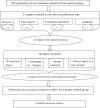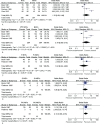Nasointestinal tubes versus nasogastric tubes in the management of small-bowel obstruction: A meta-analysis
- PMID: 30200119
- PMCID: PMC6133588
- DOI: 10.1097/MD.0000000000012175
Nasointestinal tubes versus nasogastric tubes in the management of small-bowel obstruction: A meta-analysis
Abstract
Background: There is no consensus regarding the therapeutic effect of nasointestinal tubes (NITs) versus nasogastric tubes (NGTs) in the management of small-bowel obstruction (SBO). This study aimed to compare the clinical outcomes between the use of NITs and NGTs in the management of SBO.
Methods: Published studies on comparing NITs with NGTs in the treatment of SBO were searched from electronic databases. Two investigators independently extracted the data; any discrepancies were adjudicated by a third investigator. Pooled odds ratio (OR) and 95% confidence interval (CI) were calculated using Review Manager 5.0.
Results: An extensive literature search identified 268 relevant publications, 4 of which met the inclusion criteria. There were no significant differences in the nonrequirement of operative intervention between NITs and NGTs groups (OR: 1.79; 95% CI: 0.55, 5.84). Compared with the NGTs, the NITs, which successfully passed through the pylorus, did not decrease the rate of operation in patients with SBO (OR: 2.19; 95% CI: 0.59, 8.15). There was no advantage of NITs over NGTs in patients with partial SBO (P-SBO) (OR: 1.04; 95% CI: 0.23, 4.60). Postoperative complications were compared between the groups (OR: 2.13; 95% CI: 1.09, 4.15).
Conclusion: The result of this meta-analysis showed no advantage of NITs over NGTs in the management of patients with SBO.
Conflict of interest statement
The authors have no conflicts of interest to disclose.
Figures



Similar articles
-
Use of tubes and radiographs in the management of small bowel obstruction.Ann Surg. 1987 Aug;206(2):126-33. doi: 10.1097/00000658-198708000-00002. Ann Surg. 1987. PMID: 3606237 Free PMC article.
-
Who would avoid severe adverse events from nasointestinal tube in small bowel obstruction? A matched case-control study.BMC Gastroenterol. 2022 Jul 7;22(1):332. doi: 10.1186/s12876-022-02405-8. BMC Gastroenterol. 2022. PMID: 35799135 Free PMC article.
-
Management of small bowel obstruction and systematic review of treatment without nasogastric tube decompression.Surg Open Sci. 2022 Nov 7;12:62-67. doi: 10.1016/j.sopen.2022.10.002. eCollection 2023 Mar. Surg Open Sci. 2022. PMID: 36992798 Free PMC article. Review.
-
A prospective, randomized trial of short versus long tubes in adhesive small-bowel obstruction.Am J Surg. 1995 Oct;170(4):366-70. doi: 10.1016/s0002-9610(99)80305-5. Am J Surg. 1995. PMID: 7573730 Clinical Trial.
-
Emergency Medicine Evaluation and Management of Small Bowel Obstruction: Evidence-Based Recommendations.J Emerg Med. 2019 Feb;56(2):166-176. doi: 10.1016/j.jemermed.2018.10.024. Epub 2018 Dec 6. J Emerg Med. 2019. PMID: 30527563 Review.
Cited by
-
Machine Learning Predicts the Need for Surgical Intervention in Adhesive Small Bowel Obstruction.J Anus Rectum Colon. 2024 Oct 25;8(4):323-330. doi: 10.23922/jarc.2024-036. eCollection 2024. J Anus Rectum Colon. 2024. PMID: 39473722 Free PMC article.
-
Clinical factors associated with surgical interventions in patients with intestinal obstruction caused by abdominal tuberculosis.Surg Today. 2025 Jul 8. doi: 10.1007/s00595-025-03098-8. Online ahead of print. Surg Today. 2025. PMID: 40629150
References
-
- Dijkstra FR, Nieuwenhuijzen M, Reijnen MM, et al. Recent clinical developments in pathophysiology, epidemiology, diagnosis and treatment of intra-abdominal adhesions. Scand J Gastroenterol 2000;232:52–9. - PubMed
-
- Fleshner PR, Siegman MG, Slater GI, et al. A prospective, randomized trial of short versus long tubes in adhesive small-bowel obstruction. Am J Surg 1995;170:366–70. - PubMed
-
- Becker WF. Acute adhesive ileus; a study of 412 cases with particular reference to the abuse of tube decompression in treatment. Surg Gynecol Obstet 1952;95:472–6. - PubMed
Publication types
MeSH terms
LinkOut - more resources
Full Text Sources
Other Literature Sources
Medical
Miscellaneous

